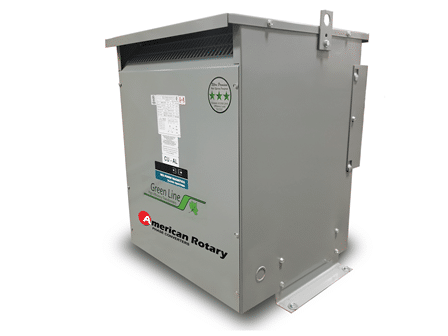WHAT YOU NEED TO KNOW WHEN BUYING A TRANSFORMER

Buying a transformer can be stressful and confusing, so American Rotary would like to help you better understand what transformers are right for you. Some things to consider when buying a transformer are:
Why do I even need a transformer?
What type of environment am I putting it in?
How do I size a transformer?
Should I buy an auto or isolation transformer?
WYE or Delta?
WHY DO I EVEN NEED A TRANSFORMER?
A transformer is needed anytime you want to raise or lower your supplied voltage. An example of this would be when you have 240v power available, but you have a machine that requires 480v power. American Rotary offers a number of solutions that will allow you to go up or down in voltage as needed.
WHAT TYPE OF ENVIRONMENT AM I PUTTING IT IN?
There are a number of different enclosure types that you may want to consider when ordering a transformer. You will want to determine if it will be going indoors or outdoors. You may also want to consider things such as corrosion, noise, or if it will be in a hazardous location. Common enclosure types are:
Type 1 – These enclosures are constructed for indoor use to provide a degree of protection against access to hazardous parts and to provide a degree of protection of the equipment inside the enclosure against the entry of solid foreign objects (falling dirt).
Another very common type of enclosure is Type 3R – These enclosures are constructed for either indoor or outdoor use to provide a degree of protection against access to hazardous parts; to provide a degree of protection of the equipment inside the enclosure against the entry of solid foreign objects (falling dirt); to provide a degree of protection with respect to harmful effects on the equipment due to the entry of water (rain, sleet, snow); and that will be undamaged by the external formation of ice on the enclosure.
American Rotary can help to determine the best NEMA rated enclosure for your situation as there are a number of other less common types that we offer by special order only.
HOW DO I SIZE A TRANSFORMER?
Sizing a transformer can seem quite complex at first, but in reality, it is quite easy if you understand the terms and abbreviations that are used. The following will help ensure you are successful in your quest for the properly sized converter.
1. The transformer size is determined by the KVA of the load.
2. Load voltage, or secondary voltage, is the voltage needed to operate the load.
3. Line voltage, or primary voltage, is the voltage from the source.
4. Single-Phase has two lines of AC power.
5. Three-Phase has three lines of AC power.
6. KVA is kilovolt ampere or thousand-volt amperes. (This is how transformers are rated).
Determine the Load Voltage
Load Voltage = ______________________
Determine the Load Current (Amps)
Load Current/Amps = __________________
Determine the Line Voltage
Line Voltage= ________________________
Then use the following calculations:
Single-Phase Transformers: Three-Phase Transformers:
Volts x Amps / 1000 = KVA Volts x Amps x 1.732 / 1000 = KVA
SHOULD I BUY AN AUTO OR ISOLATION TRANSFORMER?
To know which type of transformer is right for you, it’s probably best to get an understanding of the difference between the two. Here is a brief break down of each:
Auto-Transformer – An Auto-Transformer is an electrical transformer that contains only a single winding, a portion of which is common to both the primary and the secondary circuits. An autotransformer uses a common winding and offers no interference or isolation. Pros: inexpensive, easy to hook-up, typically smaller footprint can go Delta to Delta and Wye to Wye, many tap configurations available. Cons: No isolation, cannot go Delta to Wye.
Isolation/Distribution Transformer – An Isolation or Distribution transformer is an electrical transformer that contains two separate windings. Neither of these windings is shared with one another which allows the primary to be isolated from the secondary. The transformation in voltage between primary and secondary windings occurs as a result of the shared magnetic field in the core. Pros: Provides isolation, can go Delta to Delta, Wye to Wye, or Delta to Wye, Con’s: More expensive, larger footprint.
Wye or Delta?
Transformers can be hooked up in a Delta configuration, Wye configuration, Wye to Delta configuration, or Delta to Wye configuration. So which one is right for you? A Delta configuration uses only three-phase conductors, whereas wye-connected systems carry a fourth neutral conductor which is often grounded but sometimes left floating.
An advantage of the Delta connection is higher reliability. If one of the three primary windings fail, the secondary will still produce a full voltage on all three phases. An advantage of the Wye connection is that it can provide multiple voltages without the need for additional transformers. To know what connection is right for you, we recommend that you refer to the nameplate on your equipment.

